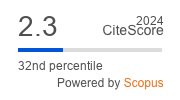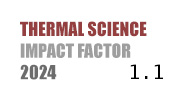THERMAL SCIENCE
International Scientific Journal
ENHANCING SUSTAINABLE FACADE DESIGN: A BELGRADE CASE STUDY
ABSTRACT
This research examines the potential of widespread façade systems to improve energy performance and enhance user comfort in residential buildings. Utilizing Design Builder software (Version 5.0.3.7), the study specifically aimed to reduce heating energy consumption, a significant concern in the climatic conditions of Serbia. The methodology incorporated both technical performance assessments and economic analyses, evaluating the economic viability through metrics such as return on investment, Net present value, and internal rate of return. The multi-criteria evaluation framework employed allowed for a comprehensive analysis, balancing technical performance with economic and qualitative factors to identify the most favorable façade systems. By addressing both the immediate economic returns and longer-term benefits, this research contributes to a more sustainable and economically feasible building practice.
KEYWORDS
PAPER SUBMITTED: 2024-05-20
PAPER REVISED: 2024-09-03
PAPER ACCEPTED: 2024-09-05
PUBLISHED ONLINE: 2024-10-12
THERMAL SCIENCE YEAR
2025, VOLUME
29, ISSUE
Issue 2, PAGES [999 - 1014]
- Azizi, S., et al., Adoption of Energy Efficiency Measures in Renovation of Single-Family Houses: A Comparative Approach, Energies, 13 (2020), 22, 6042
- Kosanović, S., et al., Energy Refurbishment of Family Houses in Serbia in Line with the Principles of Circular Economy, Sustainability, 13 (2021), 10, 5463
- Sassi, P., Strategies for Sustainable Architecture, in: Strateg. Sustain. Archit., Taylor & Francis, Oxford, UK, 2006, pp. 1-305
- Keitsch, M., Sustainable Architecture, Design and Housing, Sustain. Dev., 20 (2012), 3, pp. 141-145
- Pohl, J., Sustainable Architecture Concepts and Principles, in: Build. Sci., Wiley, New York, USA, 2011, pp. 225-258
- Maddaus, M. L.. et al., Innovative Water Conservation Supports Sustainable Housing Development, J. Am. Water Work. Assoc., 100 (2008), 5, 2008
- Pohl, J., Concepts and Applications, in: Build. Sci., Wiley, New York, USA, 2011
- Mitchell, L., Burton, M., Neighbourhoods for Life: Designing Dementia-Friendly Outdoor Environments, Qual. Ageing Older Adults, 7 (2006), 1, pp. 26-33
- Moomaw, W. R., et al., Sustainable Development Diplomacy: Diagnostics for the Negotiation and Implementation of Sustainable Development, Glob. Policy, 8 (2017), 1, pp. 73-81
- Schulz, U., et al., Some Recent Trends in Research and Technology of Advanced Thermal Barrier Coatings, Aerosp. Sci. Technol., 7 (2003), 1, pp. 73-80
- Nguyen, S. T., et al., Advanced Thermal Insulation and Absorption Properties of Recycled Cellulose Aerogels, Colloids Surfaces A Physicochem. Eng. Asp., 445 (2014), Mar., pp. 128-134
- Hu, F., et al., Hollow-Structured Materials for Thermal Insulation, Adv. Mater., 31 (2019), 38, 1801001
- Cuce, E., Riffat, S. B., A State-of-the-Art Review on Innovative Glazing Technologies, Renew. Sustain. Energy Rev., 41 (2015), Jan., pp. 695-714
- Huang, J., et al., Thermal Performance Optimization of Envelope in the Energy-Saving Renovation of Existing Residential Buildings, Energy Build., 247 (2021), 111103
- Brown, M., Innovative Energy-Efficiency Policies: An International Review, Wiley Interdiscip. Rev. Energy Environ., 4 (2015), 1, pp. 1-25
- Lopez-Ochoa, L. M., et al., Energy Renovation of Residential Buildings in Cold Mediterranean Zones Using Optimized Thermal Envelope Insulation Thicknesses: The Case of Spain, Sustain., 12 (2020), 6, 2287
- Ferreira, M., et al., Cost-Optimal Energy Efficiency Levels Are the First Step in Achieving Cost Effective Renovation in Residential Buildings with a Nearly-Zero Energy Target, Energy Build., 133 (2016), Dec., pp. 724-737
- Bertoldi, P., et al., How to Finance Energy Renovation of Residential Buildings: Review of Current and Emerging Financing Instruments in the EU, Wiley Interdiscip. Rev. Energy Environ., 10 (2021), 1, e384
- Achintha, M., Sustainability of Glass in Construction, in: Sustain. Constr. Mater., Woodhead Publishing, Samston, UK, 2016, pp. 79-104
- Lu, J. X., Poon, C. S., Recycling of Waste Glass in Construction Materials, in: New Trends Eco-Efficient Recycl. Concr., Woodhead Publishing, Samston, UK, 2018, pp. 153-167
- Stevanović, S., Optimization of Passive Solar Design Strategies: A Review, Renew. Sustain. Energy Rev., 25 (2013), Sep., pp. 177-196
- Grewal, K. S., et al., Decision-Making Method to Prioritize and Implement Solar Strategies on Neighborhood Level, Energy Reports, 12 (2024), Dec., pp. 2062-2076
- Athieniti, A. K., Santamouris, M., Thermal Analysis and Design of Passive Solar Buildings, Taylor & Francis, Oxford, UK, , 2013, 296
- Ghazi, S., Ip, K., The Effect oof Weather Conditions on the Efficiency of PV Panels in the Southeast of UK, Renew. Energy, Elsevier, Amsterdam, The Netherlands, 2020, Vol. 6, pp. 50-59
- Jovanović Popović, M., et al., Atlas porodičnih kuća Srbije (Atlas of Family Hosuseing in Serbia - in Serbian), Arhitektonski fakultet Univerziteta u Beogradu, Belgrade, Serbia, 2012
- Pawar, B. S., Kanade, G. N., Energy Optimization of Building Using Design Builder Software, International Journal of New Technology and Research, 4 (2018), 1
- Mouter, N., et al., Comparing Cost-Benefit Analysis and Multi-Criteria Analysis, in: Advances in Transport Policy and Planning, Elsevier, Amsterdam, The Netherlands, 2020, Vol. 6, pp. 225-254
- Mishan, E. J., Quah, E., Cost-Benefit Analysis, 6th ed., Routledge, London, UK, 2020
- Ekardt, F., Cost-Benefit Analysis without Convincing Theoretical Basis, Part in: Economic Evaluation, Cost-Benefit Analysis, Economic Ethics, Part of: Environmental Humanities: Transformation, Governance, Ethics, Law, Springer, Cham, Switzerland, 2022
- Elariane, S. A., Dube, J., Is Smart Housing a Good Deal, An Answer Based on Monte Carlo Net Present Value Analysis, Sustainability, 11 (2019), 15, 4193
- Kan, I., et al., The Application of Multicriteria Decision Analysis Methods in Health Care: A Literature Review, Medical Decision Making, 42 (2022), 2, pp. 262-274
- Todorović, M., Rajčić, A., Priručnik za energetsku sertifikaciju zgrada - Vodič za investiture, izvođače i projektante (Handbook for Energy Certification of Buildings - Guide to Investments, Coutractors, and Designers - in Serbian), Mašinski fakultet Univerziteta u Beogradu, Belgrade, Serbia, 2017
- Мarković, Lj., et al., Multi-Criteria Decision-Making when Choosing Variant Solution of Highway Route at the Level of Preliminary Design, FACTA UNIVERSITATIS Series Architecture and Civil Engineering, 11 (2013), 1, pp. 71-87
- Opricović, S., Tzeng, G. H., Extended VIKOR Method in Comparison with Outranking, European Journal of Operational Research, 178 (2007), 2, pp. 514-529
- +++, Делпхи метода - шта је то, дефиниција и концепт | Речник 2024 (no date). Available at: sr.economy-pedia.com/11038201-delphi-method, 2024
- Harmathy, N., Analysis of Smart Building Solutions for Optimizing the Energy, Thermal Science, 26 (2022), 4A, pp. 3119-3132
- +++, International Energy Outlook 2016 With Projections to 2040 (Technical Report) | OSTI.GOV, www.osti.gov/biblio/1296780, 2024

